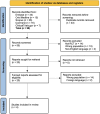Cold Atmospheric Pressure Plasma in the Treatment of Diabetic Foot Ulcers: A Systematic Review
- PMID: 40320289
- PMCID: PMC12050158
- DOI: 10.1111/iwj.70517
Cold Atmospheric Pressure Plasma in the Treatment of Diabetic Foot Ulcers: A Systematic Review
Abstract
Cold atmospheric pressure plasma (CAPP) is an innovative energy-based therapy which has gained momentum in recent years for its wide array of therapeutic applications. This systematic review aims to evaluate the effectiveness and safety of CAPPs in treating diabetic foot ulcers. We conducted systematic literature searches on Embase, Ovid Medline, Scopus, Cochrane Central Register of Controlled Trials, The Cochrane Database of Systematic Reviews and Clinicaltrials.gov using PRISMA guidelines. We searched for randomised controlled trials (RCTs) and observational studies conducted on patients with diabetic foot ulcers in which CAPP therapy was compared with a control treatment. The risk of bias was assessed using the Cochrane Collaboration tool. Four RCTs from two countries analysing a total of 153 patients were included in the review. Three studies reported a significant reduction in ulcer area in the CAPP group, one study reported a significant decrease in inflammatory markers, and mixed results were reported regarding the reduction of bacterial load. All studies reported no adverse side effects or concerns with the safety profile of CAPP. Current evidence supports CAPP's potential as safe and effective adjunctive therapy that may accelerate wound healing, reduce wound size, promote tissue regeneration and lower infection risks. However, the limited number and size of trials, variability in treatment protocols and short follow-up periods highlight the preliminary nature of these findings. Further large-scale, well-designed studies with standardised protocols and long-term follow-up are needed to confirm CAPP's efficacy and safety, as well as to determine its cost-effectiveness in diverse healthcare settings.
Keywords: cold atmospheric pressure plasma; diabetes mellitus; diabetic foot; foot ulcer.
© 2025 The Author(s). International Wound Journal published by Medicalhelplines.com Inc and John Wiley & Sons Ltd.
Conflict of interest statement
The authors declare no conflicts of interest.
Figures
References
-
- Hinchliffe R. J., Forsythe R. O., Apelqvist J., et al., “Guidelines on Diagnosis, Prognosis, and Management of Peripheral Artery Disease in Patients With Foot Ulcers and Diabetes (IWGDF 2019 Update),” Diabetes/Metabolism Research and Reviews 36, no. Suppl 1 (2020): e3276, 10.1002/dmrr.3276. - DOI - PubMed
Publication types
MeSH terms
Substances
LinkOut - more resources
Full Text Sources
Medical



